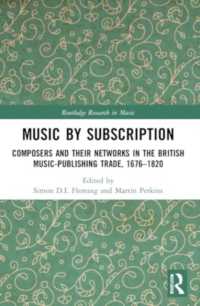Full Description
This edited volume brings together researchers and practitioners who work in various linguistic frameworks and EAP contexts, with contributions from Australia, Canada, New Zealand, Singapore, Sweden, UAE, the UK, Ukraine and the USA. It extends existing linguistic research further by applying theories and approaches and by investigating genres that have received little attention in EAP so far, such as Complex Dynamic Systems Theory, Grice's Cooperative Principle and the article comments and university seminar genres, amongst others.
The volume provides linguistic description of both student and expert genres and provides clear pedagogical implications, in the form of teaching recommendations, suggested teaching activities, evaluation of teaching materials or a practical methodological approach. Overall, by focusing on new areas of linguistic research in EAP, the volume enhances teaching practice and inspires further research and scholarship.
Contents
List of Figures
List of Tables
Notes on Contributors
Series Editors Foreword
Acknowledgements
1. Introduction, Milada Walková (University of Leeds, UK)
Part I: Fluency and Range of Expression
2. Formulaic Language in University Seminars: A Comparison of EAP Textbook Coverage and Authentic Language Use in ELF Settings, Ying Wang (Karlstad University, Sweden) and Nok Chin Lydia Chan (Karlstad University, Sweden)
3. Moves away from Congruence: Interpersonal, Logical and Grammatical Metaphor in EAP, Jennifer Walsh Marr (University of British Columbia, Canada)
Part II: Complexity and Accuracy
4. The Role of Morphological Knowledge in EAP Writing: Evidence-Based Study, Elizaveta Tarasova (Institute of the Pacific United, New Zealand) and Natalia Beliaeva (KiwiClass Multicultural Support Services, New Zealand)
5. Non-Finite Clause Use in Novice and Expert Academic Writing: A Corpus Driven Analysis for EAP Writing Instruction, J. Elliott Casal (University of Memphis, USA) and Xixin Qiu (Pennsylvania State University, USA)
6. Applying Complex Dynamic Systems Theory in EAP Curriculum Design and Teaching Practice: Challenges and Possibilities, Rosmawati (Singapore Institute of Technology, Singapore)
Part III: Appropriateness to Academic Rhetorical Conventions
7. How Does Academic Writing Produced for the Abstracts of Articles in More and Less Prestigious Journals Reflect Grice's Maxims?, Mark Wyatt (Khalifa University, UAE)
8. Evaluative Genres of Research Communication: Article Comments and Peer Reviews from Linguistic and Pedagogical Perspectives, Tatyana Yakhontova (Ivan Franko National University of Lviv, Ukraine)
9. Conceptual Metaphors as a Resource to Build a Coherent Text: A Socio-Cognitive Approach to EAP, Tomoko Sawaki (independent researcher)
Index








